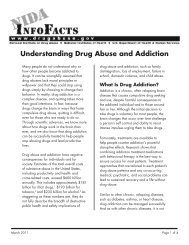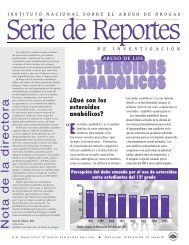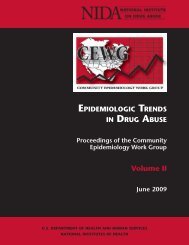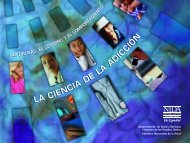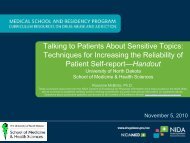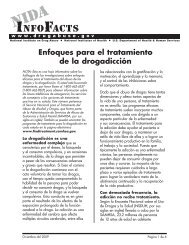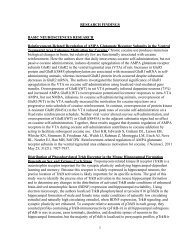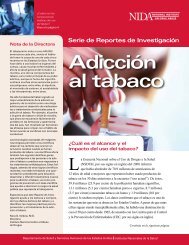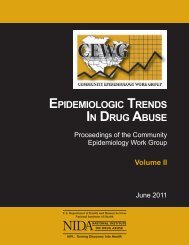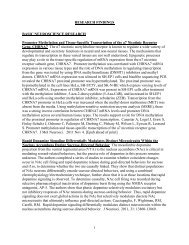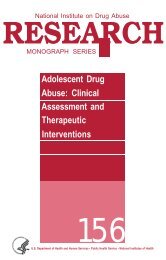CEWG January 09 Full Report - National Institute on Drug Abuse
CEWG January 09 Full Report - National Institute on Drug Abuse
CEWG January 09 Full Report - National Institute on Drug Abuse
You also want an ePaper? Increase the reach of your titles
YUMPU automatically turns print PDFs into web optimized ePapers that Google loves.
EpidEmiologic TrEnds in drug AbusE: HigHligHTs And ExEcuTivE summAry<br />
2,110 in 2004, but then climbed steadily to 3,212<br />
by 2007. Methamphetamine, which accounted<br />
for the next highest proporti<strong>on</strong> of treatment admissi<strong>on</strong>s<br />
statewide (excluding alcohol), overtook<br />
cocaine admissi<strong>on</strong>s in the first half of 2003. Methamphetamine<br />
admissi<strong>on</strong>s c<strong>on</strong>tinued to increase<br />
until the first half of 2006 (31 percent), remained<br />
stable through 2007, but then declined in the first<br />
half of 2008 (26 percent). In greater Denver,<br />
methamphetamine represented 22 percent of first<br />
half of 2006 admissi<strong>on</strong>s, increased to 23 percent<br />
in the first half of 2007, but then declined to just<br />
19 percent in the first half of 2008. Greater Denver<br />
methamphetamine admissi<strong>on</strong>s were behind<br />
cocaine in all three of these time periods. Methamphetamine<br />
ED reports in greater Denver totaled<br />
266 in the first half of 2008, accounting for<br />
just 6 percent of unweighted DAWN reports (excluding<br />
alcohol). While methamphetamine was<br />
not am<strong>on</strong>g the most comm<strong>on</strong> drugs found in<br />
Denver drug-related decedents, it still accounted<br />
for 7.1 percent of Denver drug-related mortality<br />
in 2005, 5.3 percent in 2006, and 6.3 percent in<br />
2007. Methamphetamine was the third most<br />
comm<strong>on</strong> drug submitted for testing by local law<br />
enforcement in the first half of 2008 in Denver,<br />
Arapahoe, and Jeffers<strong>on</strong> Counties. Federal drug<br />
seizures for methamphetamine across Colorado<br />
increased each year from 2003 (14.8 kilograms) to<br />
2006 (50.3 kilograms), but then declined to <strong>on</strong>ly 8<br />
kilograms in 2007. Likewise, methamphetamine<br />
lab seizures in Colorado have declined from 345<br />
in 2003 to <strong>on</strong>ly 44 in 2007. Cocaine admissi<strong>on</strong>s<br />
(excluding alcohol) statewide declined slightly<br />
from 21 percent in both the first half of 2006 and<br />
2007 to 20 percent in the first half of 2008. Similarly,<br />
Denver area cocaine admissi<strong>on</strong>s had increased<br />
from 23 percent in the first half of 2006 to<br />
24 percent in the first half of 2007, but then decreased<br />
slightly to 22 percent in the first half of<br />
2008. In the first half of 2008, there were 1,436<br />
cocaine ED reports, which at 31 percent of greater<br />
Denver unweighted DAWN reports, was the<br />
highest number of reports am<strong>on</strong>g all drugs excluding<br />
alcohol. Likewise, excluding alcohol,<br />
cocaine was the most comm<strong>on</strong> drug reported in<br />
substance abuse-related hospital discharges in<br />
2007, a trend extending from calendar year (CY)<br />
2000. Cocaine was also the most comm<strong>on</strong> drug<br />
found in Denver drug-related decedents in 2005<br />
(48.2 percent), 2006 (50.3 percent), and 2007<br />
(39.7 percent). Likewise, cocaine in combinati<strong>on</strong><br />
with other drugs (i.e., morphine, codeine, alcohol,<br />
and heroin) was am<strong>on</strong>g the most comm<strong>on</strong><br />
combinati<strong>on</strong>s found in Denver drug-related decedents<br />
in the 2005 to 2007 time period. C<strong>on</strong>tinuing<br />
the scenario of cocaine dominance in the<br />
greater Denver area, cocaine was the most comm<strong>on</strong><br />
drug submitted for testing by local law enforcement<br />
in the first half of 2008 in Denver and<br />
Arapahoe Counties, and ranked sec<strong>on</strong>d after cannabis<br />
in Jeffers<strong>on</strong> County. Federal drug seizures<br />
for cocaine across Colorado, after decreasing<br />
from 65.5 to 36 kilograms from 2003 to 2004, increased<br />
substantially in 2005 (131.5 kilograms)<br />
and 2006 (135.1 kilograms), but declined sharply<br />
in 2007 (44.0 kilograms). In the first half of 2008,<br />
heroin ranked fourth in both statewide and greater<br />
Denver treatment admissi<strong>on</strong>s, representing 7<br />
and 11 percent of admissi<strong>on</strong>s (excluding alcohol),<br />
respectively. Heroin accounted for 8 percent of<br />
unweighted DAWN reports in the first half of<br />
2008 (n=379), ranking fourth behind cocaine,<br />
marijuana, and other opiates. Heroin was found<br />
in 11.2, 9.5, and 10.1 percent of Denver drugrelated<br />
decedents in 2005, 2006, and 2007, respectively.<br />
However, it is likely that this percentage<br />
was much greater. The marker for heroin, the metabolite<br />
6-m<strong>on</strong>oacetylmorphine, needs to be<br />
present to c<strong>on</strong>firm that heroin was related to the<br />
cause of death. However, this metabolite has a<br />
very short half-life and may be undetectable by<br />
the time blood toxicology is d<strong>on</strong>e as part of an<br />
autopsy. Morphine and codeine almost always are<br />
present when heroin is metabolized, but are also<br />
abused opiates. Thus, it is sometimes diffcult to<br />
determine whether heroin was involved in a drugrelated<br />
death. Often, an autopsy report will describe<br />
the circumstances surrounding a drugrelated<br />
death including informati<strong>on</strong> such as<br />
44<br />
Proceedings of the Community Epidemiology Work Group, <str<strong>on</strong>g>January</str<strong>on</strong>g> 20<str<strong>on</strong>g>09</str<strong>on</strong>g>



